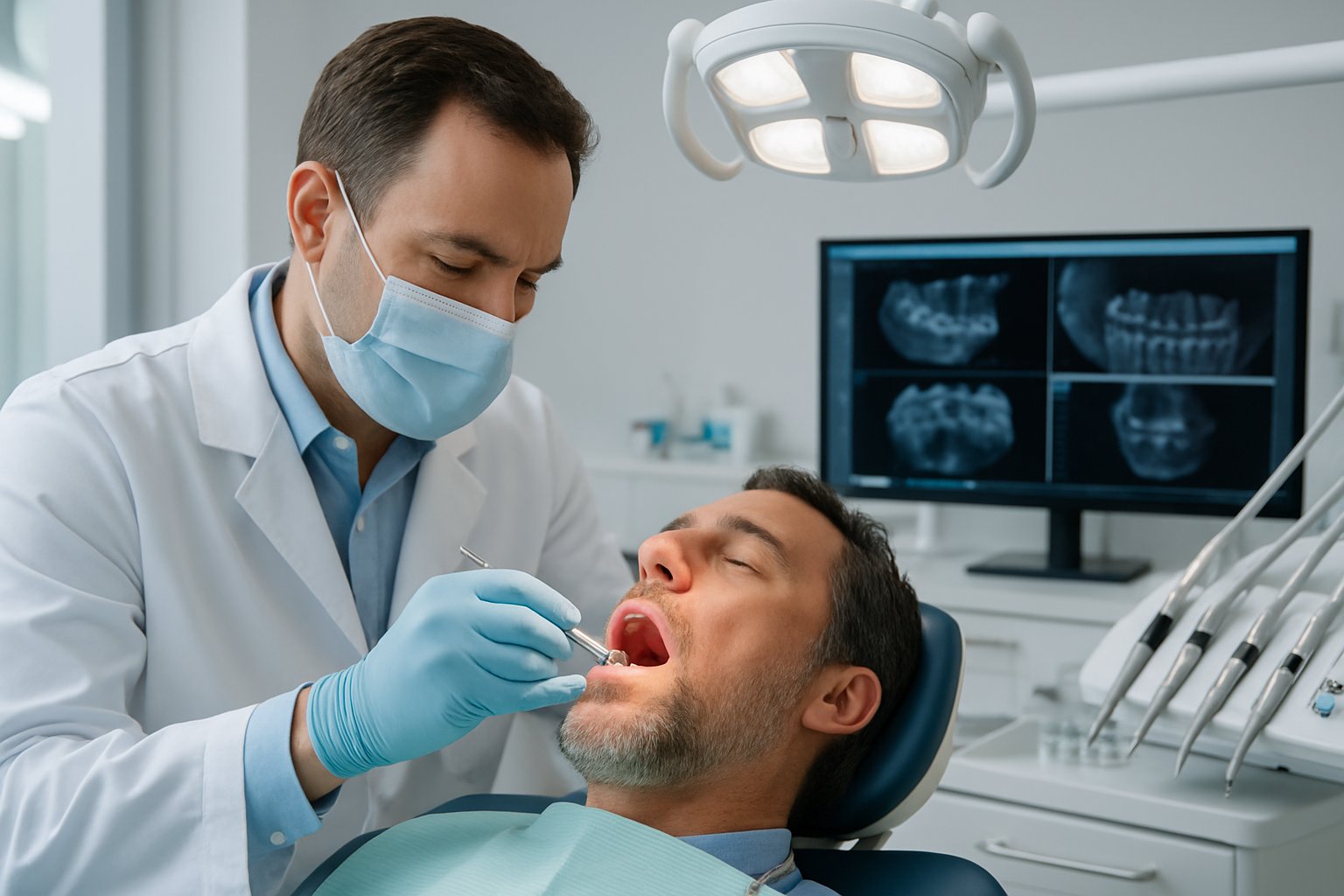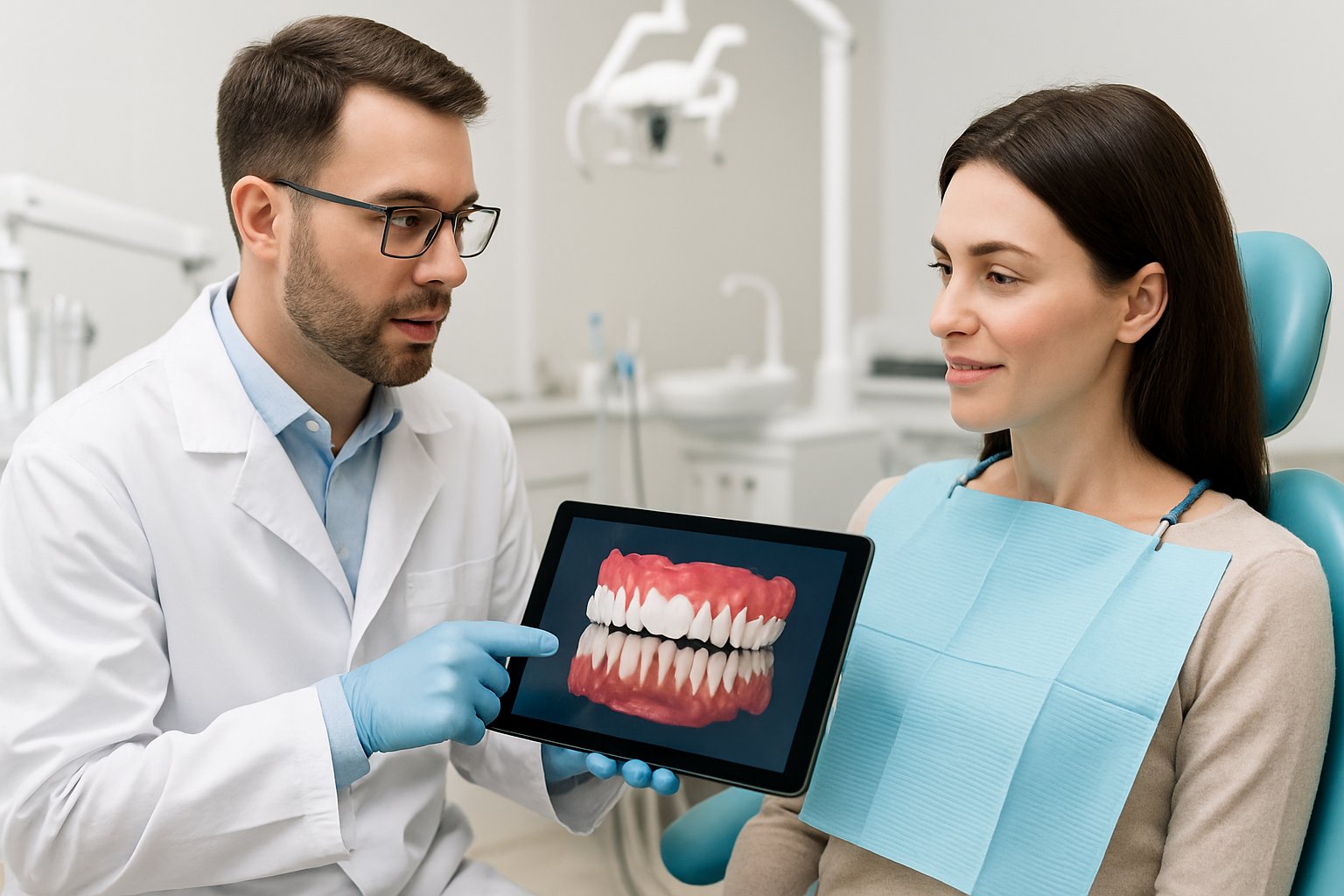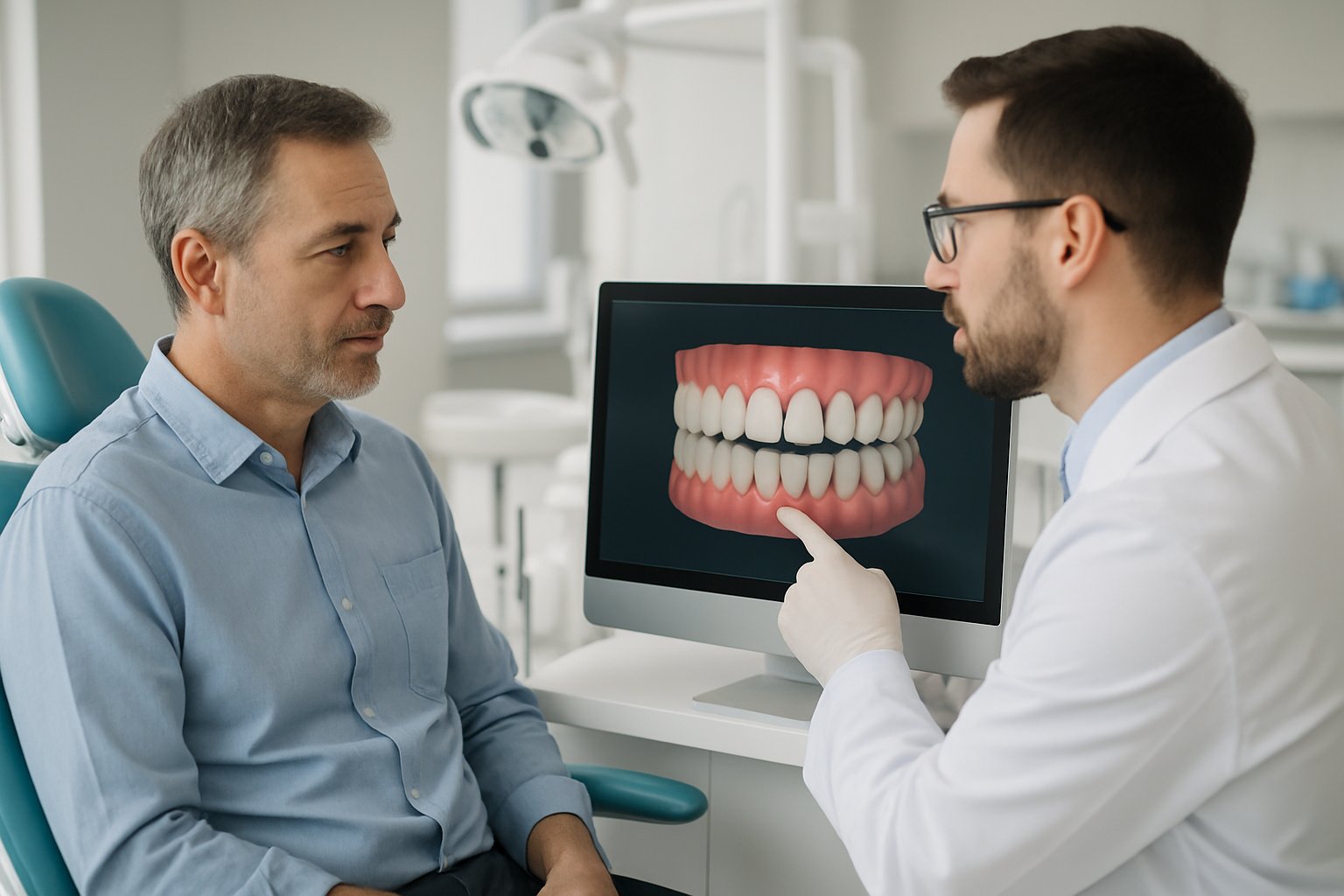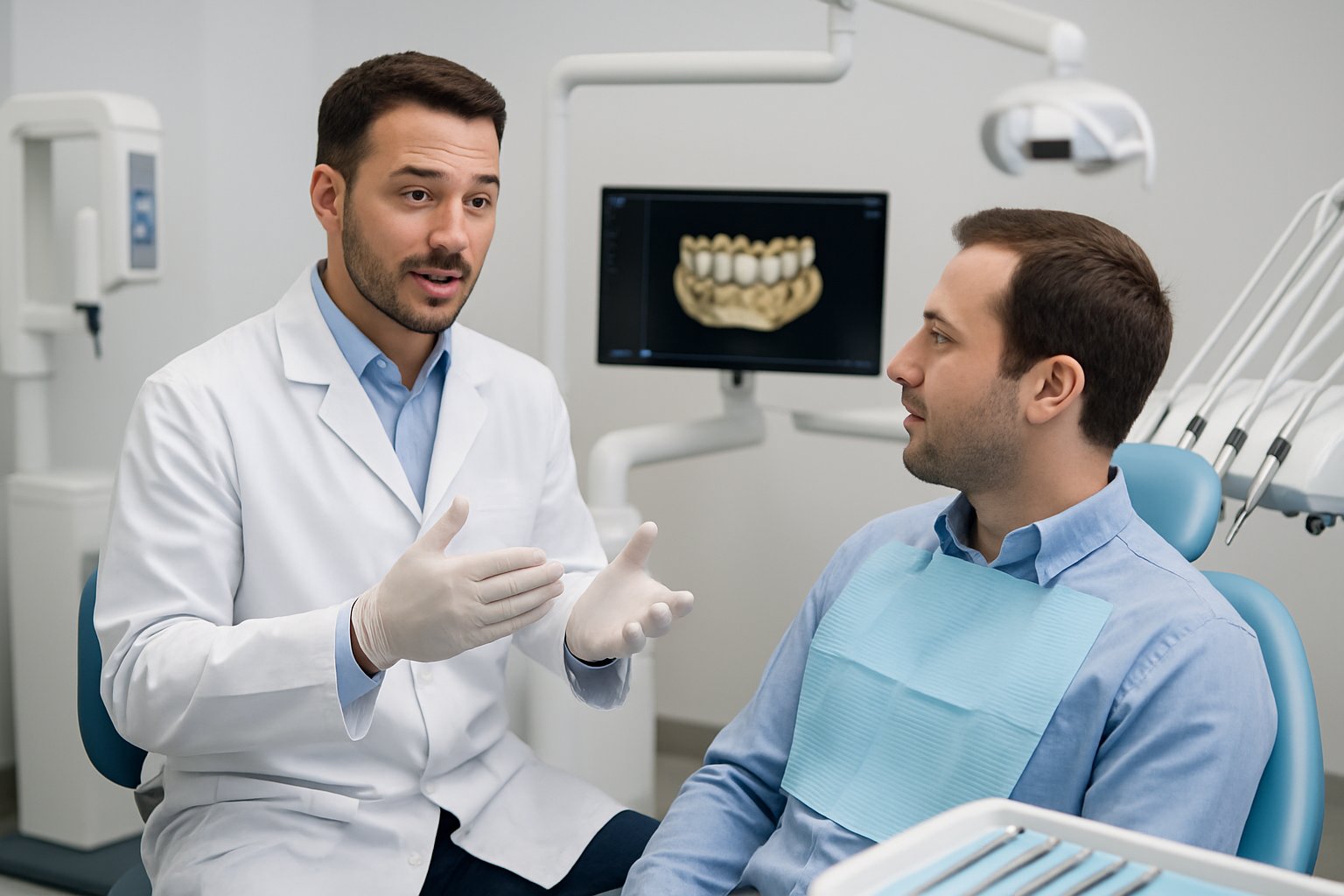Full Mouth Reconstruction: When Is It Necessary and What to Expect

Full mouth reconstruction becomes necessary when damage, disease, or wear affects most or all of your teeth. You may need it when restoring one or two teeth isn’t enough to bring back proper function, comfort, and appearance.
This can happen due to severe decay, injury, bite problems, or long-term neglect.
We look at more than just the teeth. The gums, jaw joints, and bite alignment all play a role in deciding if a full reconstruction is the right choice.
By addressing every part of the mouth, we restore health, function, and a natural look.
If eating, speaking, or smiling feels difficult or uncomfortable, it may be time to explore this option.
Key Takeaways
- Full mouth reconstruction restores function, health, and appearance.
- It’s needed when multiple teeth and supporting structures are damaged.
- Treatment plans address teeth, gums, bite, and jaw alignment.
What Is Full Mouth Reconstruction?

Full-mouth reconstruction combines several dental treatments to restore both the function and appearance of all or most teeth. It addresses serious oral health problems and improves chewing and speaking.
This process can help create a natural, functional smile.
Definition and Scope
Full-mouth reconstruction, also called full-mouth rehabilitation, is a customized plan that repairs or replaces teeth across the entire mouth. It often includes crowns, bridges, dental implants, veneers, and orthodontics.
We use this treatment to address severe tooth wear, decay, injury, or congenital conditions that affect many teeth. The process can also include gum treatments, jaw alignment correction, and bite adjustments.
This approach is part of restorative dentistry. It focuses on restoring normal function while also improving appearance.
Each plan is unique because it depends on the patient’s oral health, needs, and goals.
Difference Between Full Mouth Reconstruction and Smile Makeover
A full-mouth reconstruction restores function and health first. A smile makeover focuses mainly on cosmetic improvements.

We often combine functional and cosmetic steps in reconstruction, but the priority is to correct problems that affect chewing, speaking, and long-term oral health.
A smile makeover may be elective, while reconstruction is usually necessary to address damage or disease.
Who Is a Candidate for Full Mouth Reconstruction?
Candidates often have multiple missing teeth, severe wear, widespread decay, or damage from trauma. People with jaw pain, bite misalignment, or chronic oral infections may also benefit.
We may recommend this treatment for patients with conditions like bruxism, advanced gum disease, or oral cancer recovery that affects the teeth and jaw.
Good candidates must have healthy gums or be willing to undergo periodontal treatment first. A stable foundation is essential for lasting results.
When Is Full Mouth Reconstruction Necessary?

We recommend full mouth reconstruction when several serious dental problems occur at the same time. This can include advanced decay, missing teeth, severe injury, gum disease, or bite issues that cause pain and damage over time.
Severe Tooth Decay and Tooth Loss
When tooth decay reaches deep into the tooth structure, fillings or crowns may no longer be enough. Large cavities can weaken teeth to the point where they break or cannot be saved.
If several teeth are lost or extracted due to decay, chewing and speaking become harder. Missing teeth can also cause the bite to shift, leading to uneven wear and jaw strain.
In cases of widespread decay or multiple missing teeth, we may need to replace them with dental implants, bridges, or dentures. This restores both function and appearance and helps prevent further bone loss in the jaw.
Extensive Damage from Trauma or Accidents
A fall, sports injury, or car accident can break or knock out several teeth at once. Sometimes, the jawbone or surrounding soft tissue is also damaged.
We often see cracked, fractured, or completely lost teeth after severe dental trauma. If the damage affects most of the mouth, repairing one or two teeth is not enough to restore proper function.
Full mouth reconstruction allows us to rebuild damaged areas, replace lost teeth, and correct alignment issues that result from the injury. This approach helps protect the remaining natural teeth and maintain a stable bite.
Complications from Gum Disease
Advanced gum disease can destroy the bone and tissue that support teeth. As the condition worsens, teeth may loosen, shift, or fall out.
In severe cases, gum disease can leave a person partially or completely edentulous, which affects chewing, speech, and facial structure.
We address gum infection first, then replace missing teeth and rebuild damaged bone where needed. Without restoring the full mouth, the remaining teeth and jaw may continue to deteriorate.
Bite Problems and Jaw Pain
A misaligned bite can cause uneven pressure on teeth, leading to cracks, wear, and sensitivity. Over time, this can also strain the jaw joints and muscles, resulting in chronic jaw pain or temporomandibular joint (TMJ) issues.
When bite problems affect most or all teeth, small adjustments are not enough. We may need to reshape teeth, replace worn restorations, or rebuild the bite entirely.
By correcting the bite through full mouth reconstruction, we can reduce jaw pain, improve chewing efficiency, and protect teeth from further damage.
Key Procedures and Treatment Options

We use a combination of restorative and cosmetic treatments to rebuild function, improve bite alignment, and restore appearance. Each option addresses specific problems such as missing teeth, damaged enamel, or worn biting surfaces.
Dental Implants and Implant Surgery
Dental implants replace missing teeth with artificial roots made of titanium. We place them into the jawbone during implant surgery.
After a healing period, we attach the final crown or bridge. Implants can support a single tooth, multiple teeth, or even a full arch.
Implant-supported bridges and implant-supported dentures offer more stability than traditional dentures.
Successful implant placement often requires healthy bone density. If bone loss is present, we may recommend bone grafting before surgery.
Implant care is similar to natural teeth and includes daily brushing, flossing, and regular dental visits.
Crowns, Bridges, and Onlays
A dental crown covers and protects a damaged or weakened tooth. We use crowns after root canal therapy, large fillings, or severe wear.
Materials include porcelain, ceramic, metal, or a combination. Dental bridges fill gaps left by missing teeth.
They anchor to nearby teeth or implants and restore chewing function. Bridges can be fixed or supported by implants for greater durability.
Onlays and inlays repair moderate tooth damage without covering the entire tooth. Onlays cover a cusp, while inlays fit within the tooth’s chewing surface.
These options preserve more natural tooth structure than full crowns.
Dentures and Partial Dentures
Traditional dentures replace all teeth in the upper or lower jaw. They rest on the gums and may use adhesive for stability.
Partial dentures replace several missing teeth and attach to remaining natural teeth with clasps or precision attachments. They help maintain proper bite and prevent shifting of remaining teeth.
Implant-supported dentures provide a more secure fit. We attach them to dental implants, which improves chewing efficiency and reduces gum irritation.
Proper fit and adjustments are important for comfort. Daily cleaning and overnight soaking help extend their lifespan.
Veneers, Bonding, and Composite Resin
Veneers are thin shells, usually porcelain, that cover the front of teeth to improve shape, size, and color. They work well for chipped, stained, or slightly misaligned teeth.
Dental bonding uses composite resin to repair chips, close gaps, or reshape teeth. It is less invasive than veneers and can be completed in one visit.
We also use composite resin for fillings to match the natural tooth color. While bonding is more affordable, it may not last as long as porcelain veneers and can stain over time.
Proper care includes avoiding hard foods and maintaining daily oral hygiene.
Planning and Maintaining Full Mouth Reconstruction
We need to prepare carefully before starting any dental reconstruction. This includes choosing the right treatments and using accurate diagnostic tools.
Consistent care after the work is complete helps ensure long-lasting results.
Comprehensive Treatment Plan
A full mouth reconstruction often combines multiple procedures such as crowns, bridges, implants, or veneers. We create a treatment plan that lists each step in the correct order.
This prevents delays and helps the mouth heal properly between procedures. We consider factors like gum health, bite alignment, and jaw function.
If gum disease is present, we treat it before starting restorative work. A clear plan also includes a timeline and cost estimate.
This helps us and the patient track progress and prepare for each stage. We may coordinate with specialists, such as periodontists or orthodontists, when complex adjustments are needed.
This teamwork improves precision and reduces the risk of complications.
Role of Diagnostic Tools and Technology
Accurate diagnosis is key to a successful reconstruction. We often use digital radiography because it provides detailed images with lower radiation than traditional X-rays.
Intraoral cameras help us show patients the current condition of their teeth and gums. This makes it easier to explain why certain treatments are necessary.
We may also use 3D imaging or cone beam CT scans for implant planning. These tools allow us to measure bone density and map nerve locations.
Digital models and simulations help us design the final look and function of the teeth before starting treatment. This reduces guesswork and increases predictability.
Oral Hygiene and Long-Term Care
After reconstruction, daily oral hygiene becomes even more important. We recommend brushing twice a day with a soft-bristled toothbrush and fluoride toothpaste.
Flossing or using interdental brushes helps clean between restorations where plaque can build up. Regular teeth cleaning appointments every 3–6 months keep the gums healthy and prevent decay around crowns or bridges.
We also check the bite and adjust restorations if needed. Small changes in alignment can prevent wear or damage over time.
Patients should avoid habits like chewing ice or using teeth to open packages, as these can crack restorations. Consistent care helps protect the investment made in dental reconstruction.
Frequently Asked Questions
We answer common concerns about costs, payment options, treatment steps, insurance coverage, provider selection, and the correct medical terms for these procedures. This helps patients make informed decisions and plan for both the financial and medical aspects of treatment.
What are the typical costs associated with a full mouth reconstruction?
The cost can range from $15,000 to over $50,000 depending on the complexity, materials, and number of procedures needed.
Factors include the type of restorations, the need for surgery, and the use of dental implants or crowns.
What are the financing options for full mouth reconstruction procedures?
Many clinics provide monthly payment plans through third-party financing companies.
You can also use personal loans, credit cards, or healthcare-specific credit lines to manage the cost.
What can patients expect before and after a full mouth reconstruction?
Before treatment, you will have exams, X-rays, and sometimes 3D scans.
After the procedure, you may need follow-up visits and temporary restorations.
The healing period can last from weeks to months.
How does dental insurance impact the cost of full mouth reconstruction?
Insurance sometimes covers part of the cost if you need procedures for medical reasons, like repairing damage from trauma or disease.
Cosmetic work is usually not covered, so you may pay a significant portion out of pocket.
How can I find a reputable clinic for full mouth restoration?
Look for licensed dentists with advanced training in prosthodontics or restorative dentistry.
Check patient reviews, before-and-after photos, and professional credentials to help you choose a qualified provider.
What are the medical terms used to describe surgical reconstruction of the mouth?
Dentists use the term prosthodontics when they restore teeth and oral structures.
Surgeons perform maxillofacial surgery to reconstruct the jaw and face.
Oral rehabilitation refers to restoring both the function and appearance of the mouth.
📞 Contact Kaufman Dentistry Today
Give us a call at (310) 838-7780 to schedule your appointment and take the first step towards a stunning smile.
You can find us at 10760 Washington Blvd., Culver City, CA 90232. We look forward to welcoming you to our practice and helping you achieve the smile of your dreams!
